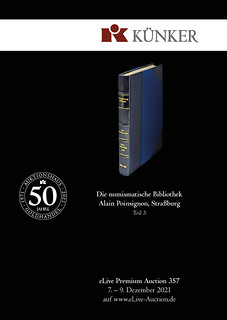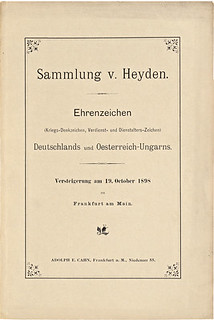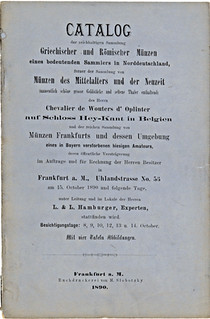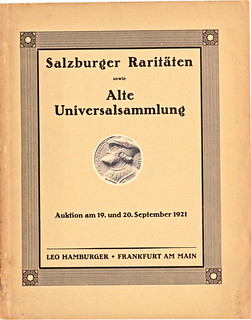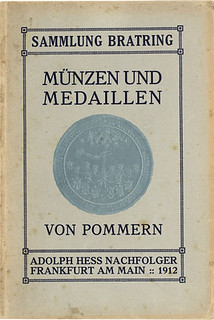
PREV ARTICLE
NEXT ARTICLE
FULL ISSUE
PREV FULL ISSUE
KÜNKER OFFERS POINSIGNON LIBRARY PART 3The final part of the numismatic library of French coin dealer Alain Poinsignon will be sold in Künker's auction 357 in November. Here's the announcement. -Editor We are pleased to present you the third and last part of the numismatic library Alain Poinsignon, Strasbourg.
This part contains nearly 2,000 lot numbers with historical auction catalogs and fixed price lists. Included are all the great names in numismatics: from Adolph E. Cahn to L. and L. Hamburger to Felix Schlessinger to Henri Rolland in Paris to Jacques Schulman in Amsterdam to Sotheby, Wilkinson and Hodge in London. Alain Poinsignon collected with precision, knowledge and passion historical auction catalogs of the 19th and early 20th century, as they are for every coin dealer of existential importance, if he cares about the provenance of important pieces. A bibliophile's delight awaits the bidder. Alain Poinsignon was himself a bibliophile in the best sense of the word and attached particular importance to proper binding. It may be surprising that we have provided all lots of this auction with a quite low standard estimate, so that every bibliophile has the best possible chance to buy a publication. The online auction takes place from 7-9 December 2021 at 5 p.m. on our eLive Auction platform. Detlev Hölscher penned an article on the history of numismatic auction catalogs as a preface to the sale. Here's an excerpt. -Editor The auction catalogues and fixed price lists form another (and at the same time the last) genre of numismatic literature in the library of Alain Poinsignon. Corresponding publications from the second half of the 19th century to about 1950, including isolated earlier lists, form the core of the collection to be auctioned here. These are mostly recorded in individual items. In addition, Alain Poinsignon has also given us a selection of his more recent catalogue holdings, most of which we have integrated into our auction in bundles, sometimes in the form of closed series. It may come as a surprise that we have given each lot in this auction a very modest standard estimate, from which a hammer price of several or many times that amount should undoubtedly result from case to case. In our experience, however, especially for the 19th and early 20th century catalogues -- some of which were produced in small editions as commercial utility products in a simple paper quality -- as well as for certain special collection catalogues, the results in today's auctions are markedly different even for items in a similar state of preservation. For this reason, we have decided to give our extensive clientele the opportunity to establish the realistic market price for each lot. With regard to the geographical origins of the collection, it should be noted that French publications are of course strongly represented here, as are German and Swiss publications. Austria and Italy are also present with relevant publications. British and US catalogues, on the other hand, are rather sparse here in view of the large number issued there. Although these publications owe their origins to commercial considerations and not to scholarly research, they form an important source group in numismatics, which their editors as a rule carefully compiled taking into account the current state of publications of the time. They offer an insight into the coin market, the companies involved in it, as well as into the original owners of those collections that flowed back into the market. In particular, those auction catalogues that were furnished by their contemporaries with authentic handwritten entries of the hammer prices, the names of the buyers and, in the best case, even the names of the respective losing counterbidders, represent extremely meaningful and valuable testimonies -- for today's collectors, professional numismatists, and also for provenance research, which must peruse a more than 700-year history of modern coin collecting and numismatic collections. The first documented auction, which among other things also included coins, took place in Leiden on 6 July 1599. It included objects from the movable estate of the writer, military officer and politician Philip St. Marnix, Lord of Sint-Adelgonde (* 1540 in Brussels, † 1598 in Leiden): especially the books from his library, but also paintings and both gold and silver coins. Of course, there were no exclusively coin dealers at that time, but jewellers and goldsmiths were also active in this field, trading not only in jewellery but also in collector coins. Early on, experts in coinage roamed the whole of Europe and parts of the Orient on behalf of aristocratic and bourgeois collectors, in search of rarities. The extent to which coin collecting was already widespread in Europe around the middle of the 16th century is documented in the travelogue of the printing entrepreneur, painter and scholar Hubert Goltzius (* 1526 in Venlo, † in Bruges). On his study trip through the Netherlands, Germany, France and Italy between 1556 and 1560, he saw no fewer than 950 coin collections. Although interest in post-antiquity history increased steadily from the 16th century onwards, coin collectors still concentrated almost exclusively on the ancient world, predominantly on the Roman era, until the 17th century. Only a few outsiders had previously dealt with medieval or even contemporary coins. Now these objects also came into the scope of collectors and authors. Thus, as early as 1592, the mayor of Göttingen, Germany, Tileman Friese, wrote the first general guide for those interested in coinage. In addition to an overview of the history of coins in antiquity and the German Middle Ages, this work contains, among other things, a discussion of German and non-German coin types. By the 17th and 18th centuries, numismatic research had advanced yet further. The holdings of the important princely collections continued to grow. During this period, coins and medals began to be separated from the heterogeneous cabinets of rarities and kept as independent collections. During the reign of Louis XIV (1643-1715), the coin collection of the French royal house developed into the most important of its time thanks to the monarch's great numismatic interest. Coin collecting had become a veritable fashion at almost all the courts of Europe. In the 18th century, coin collecting had also established itself among broad circles of the middle classes as an erudite pastime. Merchants and bankers, such as Mayer Amschel Rothschild (1743-1812), founder of the Frankfurt banking house of the same name, also became coin dealers.
Coin auctions were not at all uncommon in the 18th century. Collectors could inform themselves about the range of goods on offer through printed auction catalogues; interested parties from outside the city had the opportunity to be represented at the auction by commission agents. The number of numismatic publications now increased considerably. The first purely numismatic journal was the Several bibliographies take into account the great professional importance of numismatic auction catalogues and stock lists. The compilation of the holdings of the Fitzwilliam Museum library provides a useful, though not entirely complete, index (T[heodore]. V. Buttrey [Jr.], List of Numismatic Auction Catalogues and Fixed Price Lists, 2 vols. n.p. 2014) of related publications. The work of the art historian and collector Frits Lugt, which lists catalogues of art auctions (including coin auctions) on a large scale from the period 1625 to 1925 and beyond, should also be mentioned in this context (Frits Lugt, Répertoire des catalogues de ventes publiques, intéressant l'art ou ... monnaies médailles, camées, intailles, armes, instruments, curiosités naturelles, etc. 4 vols., The Hague 1937-1984). Further relevant bibliographies exist for the numismatic auction catalogues of certain countries, such as for the USA, for Denmark and Norway, and for Great Britain. In the case of France: As far as I know, there is no concise compilation of French coin auctions, only a compilation of those auctions in which experts for the House of Bourgey were involved -- which also has some gaps, as some smaller auctions are missing from it (Sabine Bourgey/Georges Depeyrot, Collections Numismatiques. La République Romaine, 1988). Detlef Tietjen compiled a list of German firms with the catalogue of his Auction 20 of 10 November 1976, which contained the extensive catalogue holdings from the firm library of the Münzenhandlung Richard Gaettens Jr. With this much-acclaimed work, the author introduced a numbering system for the German auction catalogues and stock lists published from 1871 to 1945, based on the respective companies. In addition, he resolved the names of collectors, which had been concealed or abbreviated in ambiguous form by the auction houses of the time for reasons of discretion. John Spring published a book on the auction catalogues from 1880 to 1980 which contained mainly ancient coins. The book not only lists them bibliographically, but also outlines the history of the coin trading companies involved and contains biographies of their last owners at the time (John Spring, Ancient Coin Auction Catalogues 1880-1990, London 2009). Our modern conception of the auction catalogue was based on Spring's work. Thus, I have dealt with the coin dealers and auction companies represented in our auction catalogue and also carried out research on the collectors listed there, who are sometimes known only by name; I have set down my conclusions drawn from this research, in particular regarding the persons and companies -- some of which have already fallen into oblivion -- who contributed a building block to the history of numismatics simply by building up collections and documenting them in the commercial catalogues.
To read the complete article, see:
To download the catalog as a .pdf, see:
To bid online, see:
THE BOOK BAZARREWayne Homren, Editor The Numismatic Bibliomania Society is a non-profit organization promoting numismatic literature. See our web site at coinbooks.org. To submit items for publication in The E-Sylum, write to the Editor at this address: whomren@gmail.com To subscribe go to: https://my.binhost.com/lists/listinfo/esylum All Rights Reserved. NBS Home Page Contact the NBS webmaster 
|
